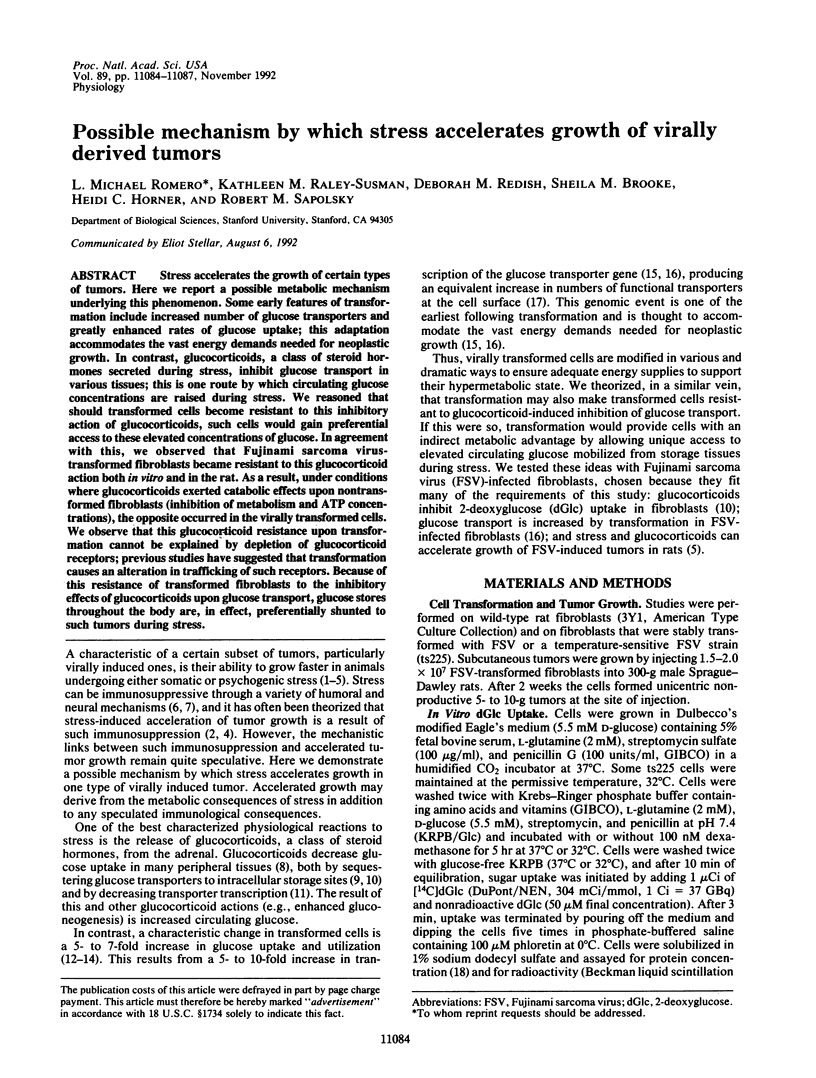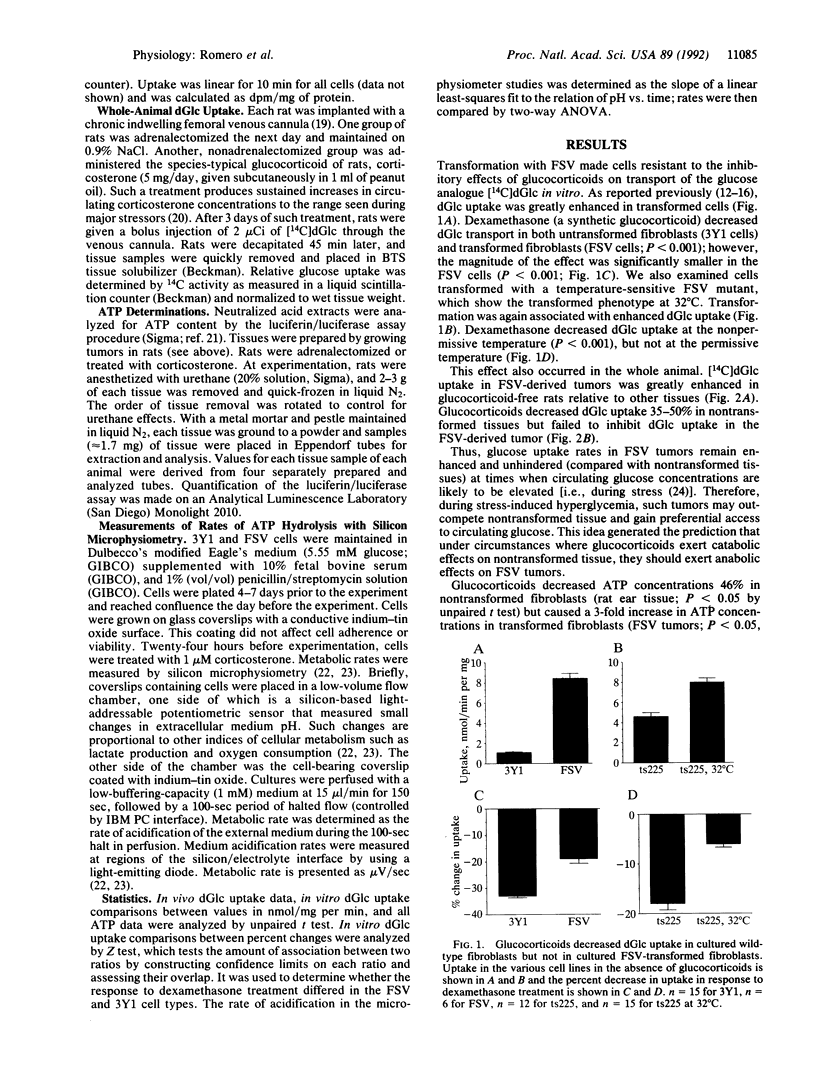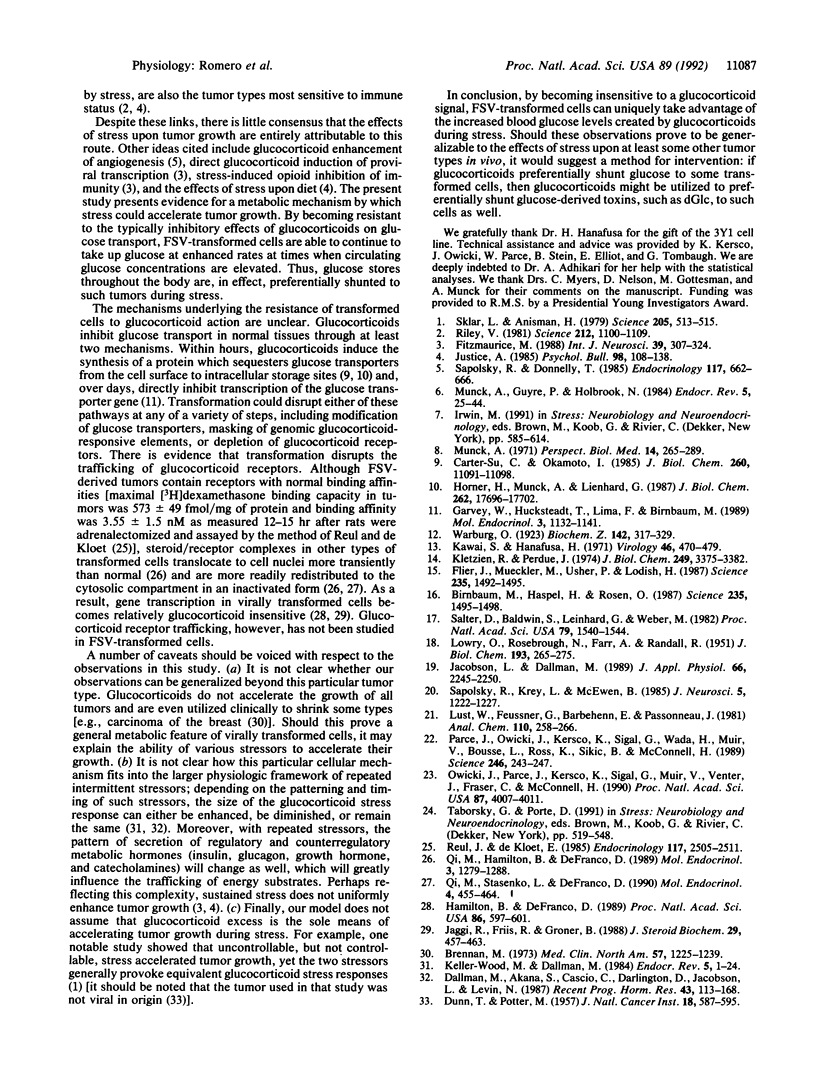Abstract
Stress accelerates the growth of certain types of tumors. Here we report a possible metabolic mechanism underlying this phenomenon. Some early features of transformation include increased number of glucose transporters and greatly enhanced rates of glucose uptake; this adaptation accommodates the vast energy demands needed for neoplastic growth. In contrast, glucocorticoids, a class of steroid hormones secreted during stress, inhibit glucose transport in various tissues; this is one route by which circulating glucose concentrations are raised during stress. We reasoned that should transformed cells become resistant to this inhibitory action of glucocorticoids, such cells would gain preferential access to these elevated concentrations of glucose. In agreement with this, we observed that Fujinami sarcoma virus-transformed fibroblasts became resistant to this glucocorticoid action both in vitro and in the rat. As a result, under conditions where glucocorticoids exerted catabolic effects upon nontransformed fibroblasts (inhibition of metabolism and ATP concentrations), the opposite occurred in the virally transformed cells. We observe that this glucocorticoid resistance upon transformation cannot be explained by depletion of glucocorticoid receptors; previous studies have suggested that transformation causes an alteration in trafficking of such receptors. Because of this resistance of transformed fibroblasts to the inhibitory effects of glucocorticoids upon glucose transport, glucose stores throughout the body are, in effect, preferentially shunted to such tumors during stress.
Full text
PDF



Images in this article
Selected References
These references are in PubMed. This may not be the complete list of references from this article.
- Birnbaum M. J., Haspel H. C., Rosen O. M. Transformation of rat fibroblasts by FSV rapidly increases glucose transporter gene transcription. Science. 1987 Mar 20;235(4795):1495–1498. doi: 10.1126/science.3029870. [DOI] [PubMed] [Google Scholar]
- Brennan M. J. Corticosteroids in the treatment of solid tumors. Med Clin North Am. 1973 Sep;57(5):1225–1239. doi: 10.1016/s0025-7125(16)32224-6. [DOI] [PubMed] [Google Scholar]
- Carter-Su C., Okamoto K. Effect of glucocorticoids on hexose transport in rat adipocytes. Evidence for decreased transporters in the plasma membrane. J Biol Chem. 1985 Sep 15;260(20):11091–11098. [PubMed] [Google Scholar]
- DUNN T. B., POTTER M. A transplantable mast-cell neoplasm in the mouse. J Natl Cancer Inst. 1957 Apr;18(4):587–601. [PubMed] [Google Scholar]
- Dallman M. F., Akana S. F., Cascio C. S., Darlington D. N., Jacobson L., Levin N. Regulation of ACTH secretion: variations on a theme of B. Recent Prog Horm Res. 1987;43:113–173. doi: 10.1016/b978-0-12-571143-2.50010-1. [DOI] [PubMed] [Google Scholar]
- Fitzmaurice M. A. Physiological relationships among stress, viruses, and cancer in experimental animals. Int J Neurosci. 1988 Apr;39(3-4):307–324. doi: 10.3109/00207458808985718. [DOI] [PubMed] [Google Scholar]
- Flier J. S., Mueckler M. M., Usher P., Lodish H. F. Elevated levels of glucose transport and transporter messenger RNA are induced by ras or src oncogenes. Science. 1987 Mar 20;235(4795):1492–1495. doi: 10.1126/science.3103217. [DOI] [PubMed] [Google Scholar]
- Garvey W. T., Huecksteadt T. P., Lima F. B., Birnbaum M. J. Expression of a glucose transporter gene cloned from brain in cellular models of insulin resistance: dexamethasone decreases transporter mRNA in primary cultured adipocytes. Mol Endocrinol. 1989 Jul;3(7):1132–1141. doi: 10.1210/mend-3-7-1132. [DOI] [PubMed] [Google Scholar]
- Hamilton B. J., DeFranco D. Glucocorticoid and cAMP induction mechanisms are differentially affected by the p85gag-mos oncoprotein. Proc Natl Acad Sci U S A. 1989 Jan;86(2):597–601. doi: 10.1073/pnas.86.2.597. [DOI] [PMC free article] [PubMed] [Google Scholar]
- Horner H. C., Munck A., Lienhard G. E. Dexamethasone causes translocation of glucose transporters from the plasma membrane to an intracellular site in human fibroblasts. J Biol Chem. 1987 Dec 25;262(36):17696–17702. [PubMed] [Google Scholar]
- Jacobson L., Dallman M. F. ACTH secretion and ventilation increase at similar arterial PO2 in conscious rats. J Appl Physiol (1985) 1989 May;66(5):2245–2250. doi: 10.1152/jappl.1989.66.5.2245. [DOI] [PubMed] [Google Scholar]
- Jaggi R., Friis R., Groner B. Oncogenes modulate cellular gene expression and repress glucocorticoid regulated gene transcription. J Steroid Biochem. 1988 May;29(5):457–463. doi: 10.1016/0022-4731(88)90179-3. [DOI] [PubMed] [Google Scholar]
- Justice A. Review of the effects of stress on cancer in laboratory animals: importance of time of stress application and type of tumor. Psychol Bull. 1985 Jul;98(1):108–138. [PubMed] [Google Scholar]
- Kawai S., Hanafusa H. The effects of reciprocal changes in temperature on the transformed state of cells infected with a rous sarcoma virus mutant. Virology. 1971 Nov;46(2):470–479. doi: 10.1016/0042-6822(71)90047-x. [DOI] [PubMed] [Google Scholar]
- Keller-Wood M. E., Dallman M. F. Corticosteroid inhibition of ACTH secretion. Endocr Rev. 1984 Winter;5(1):1–24. doi: 10.1210/edrv-5-1-1. [DOI] [PubMed] [Google Scholar]
- Kletzien R. F., Perdue J. F. Sugar transport in chick embryo fibroblasts. II. Alterations in transport following transformation by a temperature-sensitive mutant of the Rous sarcoma virus. J Biol Chem. 1974 Jun 10;249(11):3375–3382. [PubMed] [Google Scholar]
- LOWRY O. H., ROSEBROUGH N. J., FARR A. L., RANDALL R. J. Protein measurement with the Folin phenol reagent. J Biol Chem. 1951 Nov;193(1):265–275. [PubMed] [Google Scholar]
- Lust W. D., Feussner G. K., Barbehenn E. K., Passonneau J. V. The enzymatic measurement of adenine nucleotides and P-creatine in picomole amounts. Anal Biochem. 1981 Jan 15;110(2):258–266. doi: 10.1016/0003-2697(81)90144-5. [DOI] [PubMed] [Google Scholar]
- Munck A. Glucocorticoid inhibition of glucose uptake by peripheral tissues: old and new evidence, molecular mechanisms, and physiological significance. Perspect Biol Med. 1971 Winter;14(2):265–269. doi: 10.1353/pbm.1971.0002. [DOI] [PubMed] [Google Scholar]
- Munck A., Guyre P. M., Holbrook N. J. Physiological functions of glucocorticoids in stress and their relation to pharmacological actions. Endocr Rev. 1984 Winter;5(1):25–44. doi: 10.1210/edrv-5-1-25. [DOI] [PubMed] [Google Scholar]
- Owicki J. C., Parce J. W., Kercso K. M., Sigal G. B., Muir V. C., Venter J. C., Fraser C. M., McConnell H. M. Continuous monitoring of receptor-mediated changes in the metabolic rates of living cells. Proc Natl Acad Sci U S A. 1990 May;87(10):4007–4011. doi: 10.1073/pnas.87.10.4007. [DOI] [PMC free article] [PubMed] [Google Scholar]
- Parce J. W., Owicki J. C., Kercso K. M., Sigal G. B., Wada H. G., Muir V. C., Bousse L. J., Ross K. L., Sikic B. I., McConnell H. M. Detection of cell-affecting agents with a silicon biosensor. Science. 1989 Oct 13;246(4927):243–247. doi: 10.1126/science.2799384. [DOI] [PubMed] [Google Scholar]
- Qi M., Hamilton B. J., DeFranco D. v-mos oncoproteins affect the nuclear retention and reutilization of glucocorticoid receptors. Mol Endocrinol. 1989 Aug;3(8):1279–1288. doi: 10.1210/mend-3-8-1279. [DOI] [PubMed] [Google Scholar]
- Qi M., Stasenko L. J., DeFranco D. B. Recycling and desensitization of glucocorticoid receptors in v-mos transformed cells depend on the ability of nuclear receptors to modulate gene expression. Mol Endocrinol. 1990 Mar;4(3):455–464. doi: 10.1210/mend-4-3-455. [DOI] [PubMed] [Google Scholar]
- Reul J. M., de Kloet E. R. Two receptor systems for corticosterone in rat brain: microdistribution and differential occupation. Endocrinology. 1985 Dec;117(6):2505–2511. doi: 10.1210/endo-117-6-2505. [DOI] [PubMed] [Google Scholar]
- Riley V. Psychoneuroendocrine influences on immunocompetence and neoplasia. Science. 1981 Jun 5;212(4499):1100–1109. doi: 10.1126/science.7233204. [DOI] [PubMed] [Google Scholar]
- Salter D. W., Baldwin S. A., Lienhard G. E., Weber M. J. Proteins antigenically related to the human erythrocyte glucose transporter in normal and Rous sarcoma virus-transformed chicken embryo fibroblasts. Proc Natl Acad Sci U S A. 1982 Mar;79(5):1540–1544. doi: 10.1073/pnas.79.5.1540. [DOI] [PMC free article] [PubMed] [Google Scholar]
- Sapolsky R. M., Donnelly T. M. Vulnerability to stress-induced tumor growth increases with age in rats: role of glucocorticoids. Endocrinology. 1985 Aug;117(2):662–666. doi: 10.1210/endo-117-2-662. [DOI] [PubMed] [Google Scholar]
- Sapolsky R. M., Krey L. C., McEwen B. S. Prolonged glucocorticoid exposure reduces hippocampal neuron number: implications for aging. J Neurosci. 1985 May;5(5):1222–1227. doi: 10.1523/JNEUROSCI.05-05-01222.1985. [DOI] [PMC free article] [PubMed] [Google Scholar]
- Sklar L. S., Anisman H. Stress and coping factors influence tumor growth. Science. 1979 Aug 3;205(4405):513–515. doi: 10.1126/science.109924. [DOI] [PubMed] [Google Scholar]



